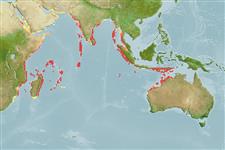Preferred temperature (Ref.
123201): 25.7 - 29.3, mean 28.2 °C (based on 685 cells).
Phylogenetic diversity index (Ref.
82804): PD
50 = 0.5000 [Uniqueness, from 0.5 = low to 2.0 = high].
Bayesian length-weight: a=0.01023 (0.00477 - 0.02194), b=3.02 (2.84 - 3.20), in cm total length, based on LWR estimates for this (Sub)family-body shape (Ref.
93245).
Mức dinh dưỡng (Ref.
69278): 3.0 ±0.2 se; based on size and trophs of closest relatives
Thích nghi nhanh (Ref.
120179): Chiêù cao, thời gian nhân đôi của chủng quần tối thiểu là dưới 15 tháng (Preliminary K or Fecundity.).
Fishing Vulnerability (Ref.
59153): Low vulnerability (10 of 100).
Nutrients (Ref.
124155): Calcium = 106 [56, 219] mg/100g; Iron = 0.758 [0.372, 1.368] mg/100g; Protein = 18.9 [17.0, 20.5] %; Omega3 = 0.162 [0.072, 0.294] g/100g; Selenium = 19.1 [9.3, 42.6] μg/100g; VitaminA = 131 [36, 450] μg/100g; Zinc = 2.02 [1.35, 2.98] mg/100g (wet weight);
